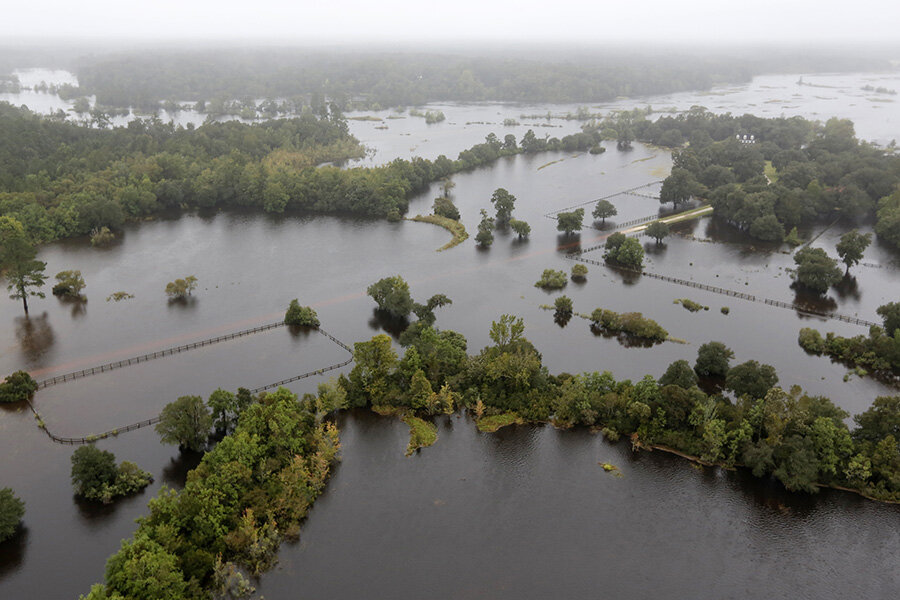9 now reported dead from S. Carolina flooding; boil water orders in effect
Loading...
| Columbia, S.C.
After a week of steady rain, the showers tapered off Monday and an inundated South Carolina turned to surveying a road system shredded by historic flooding, and in a cruel twist, thousands of residents faced the prospect of going days without running water.
The governor warned communities downstream, near the low-lying coast, that they may still see rising water and to be prepared for more evacuations. More than 900 people were already staying in shelters and nearly 40,000 people were without water.
At least 11 weather-related deaths in two states were blamed on the vast rainstorm, with one of the latest coming when a sedan drove around a barricade and stalled in rushing waters. The driver drowned, but a woman who was riding in the car managed to climb on top of it and was rescued by a firefighter who waded into the water.
"She came out the window. How she got on top of the car and stayed there like she did with that water— there's a good Lord," Kershaw County Coroner David West said.
On Monday, the rains moved north into North Carolina and the mid-Atlantic states. The rainstorm is part of an unprecedented system that dumped more than a foot of rain across South Carolina and drenched several other states.
Sunday was the wettest day in the history of South Carolina's capital city Columbia, according to the National Weather Service.
The 16.6 inches of rain that fell on Gills Creek near downtown Columbia on Sunday was the rainiest day in one single spot in the US in more than 16 years, among weather stations with more than 50 years of record-keeping. There was so much rain there, a gauge was swept off a bridge and had to be replaced by members of the US Geological Survey.
The last time there was that much rain in one spot on a single day in the US was Sept. 16, 1999, when 18.3 inches fell on Southport, North Carolina, during Hurricane Floyd.
"The flooding is unprecedented and historical," said Dr. Marshall Shepherd, a meteorologist and director of the atmospheric sciences program at the University of Georgia.
He said the unique double punch of the upper level low — aided by a "river" of tropical moisture in the atmosphere from Hurricane Joaquin spinning far out in the Atlantic — gave the monster rainstorm its punch.
South Carolina Gov. Nikki Haley has said the deluge is the kind of storm seen only once in 1,000 years.
On Monday, she said 550 roads and bridges were closed across the state. All will have to be checked for structural integrity, which could take weeks or longer.
She said floodwaters will continue to rise in some areas as rainwater runs down the state toward the coast.
"This is not over. Just because the rain stops does not mean that we are out of the woods," Haley said at a news conference.
Haley, a Republican, also thanked President Obama for a disaster declaration that frees up federal resources and for personally calling her Monday morning.
"He was extremely gracious and kind," she said.
Haley said that nine people have died in the state since the storm started. Two additional weather-related deaths were reported in North Carolina.
At least three people were killed Sunday in South Carolina, including a transportation worker who died overseeing work near downtown Columbia, a woman who was swept away in her SUV and the man who drove around the barricade Sunday night in the Lugoff community northeast of Columbia, said the coroner said.
McArthur Woods, 56, drowned after his car was inundated. His passenger was rescued when someone who heard her screams called 911 around 10 p.m.
Haley said that 25 emergency shelters are open, housing more than 900 people. Utility crews, meanwhile, were working to restore power to 26,000 people still without power, she said.
The flooding forced hundreds of weekend rescues and threatened the drinking water supply for Columbia, with officials warning some could be without potable water for days because of water main breaks. The capital city told all 375,000 of its water customers to boil water before drinking.
The situation required firefighters from several departments to use a half-dozen fire trucks and pumps to deliver hundreds of thousands of gallons of water to Palmetto Health Baptist Hospital in downtown Columbia.
Capt. Isaac Romey of the Columbia Fire Department said "the tankers pull the water out of the hydrants, move it into dump tanks and then pull it into the hospital." The water was not for consumption.
Elsewhere, nearly 75 miles of Interstate 95 — the main link from the Southeast US to the Northeast — was closed.
Columbia Police Chief William Holbrook issued a statement Monday saying search teams would check for any people still needing evacuation, and crews will mark the front doors of homes checked with a fluorescent orange X once searched.
Many schools and colleges, including the University of South Carolina, canceled classes Monday and Tuesday, and some businesses planned to stay shuttered. State climatologists have said the sun could peek out Tuesday.
In the Florence area, Robert Finger thought nothing about driving through water standing only about 6 inches deep on a country road — shallow enough that he could see the painted lines. But that was enough to leave him stranded for hours.
Finger said he sat inside his stalled vehicle from about 3 p.m. Sunday until 8 a.m. Monday, when a sheriff's deputy happened upon him.
"I was driving through a low spot, and my engine cut out because water got into the electronics," said Finger, 35, of Florence, as he dried out at a Baptist church serving as one of Florence County's evacuation shelters. "Somebody behind me pushed me up and out, and I just sat on the side of the road, reading."







